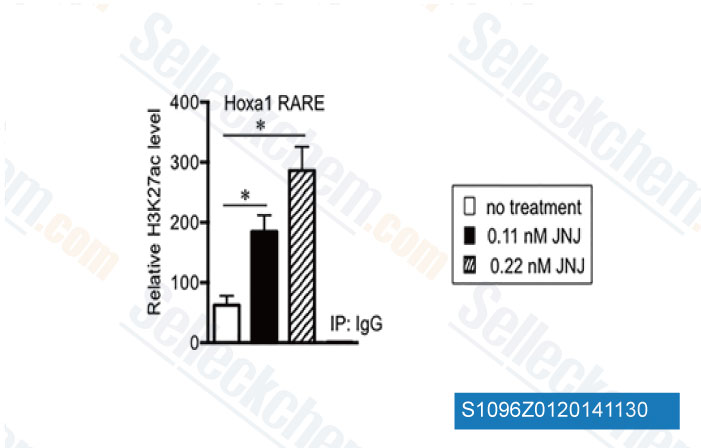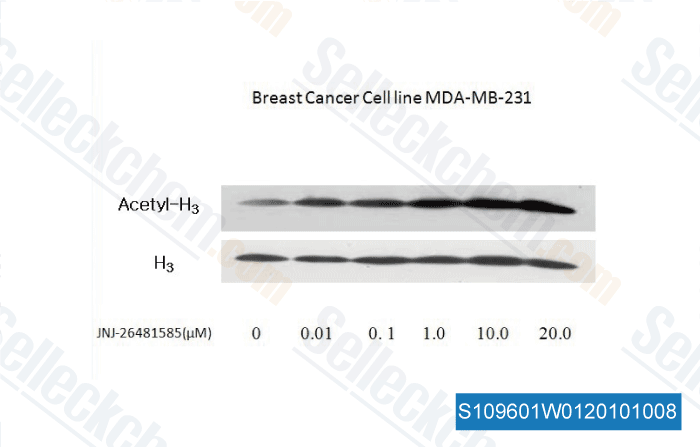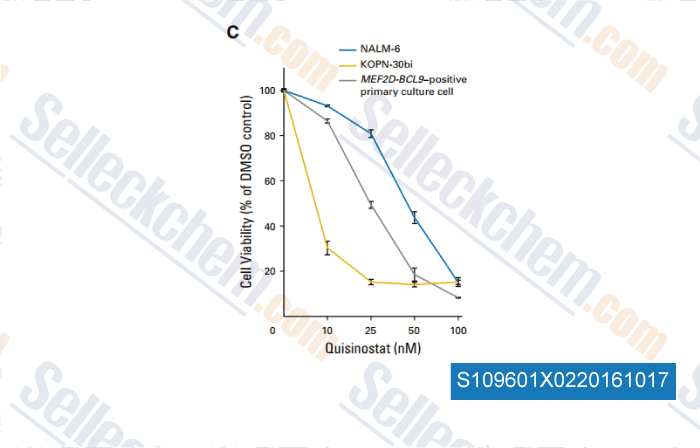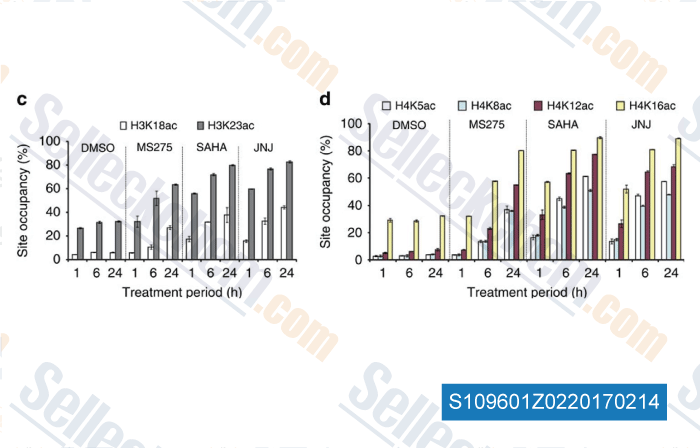|
Toll Free: (877) 796-6397 -- USA and Canada only -- |
Fax: +1-832-582-8590 Orders: +1-832-582-8158 |
Tech Support: +1-832-582-8158 Ext:3 Please provide your Order Number in the email. |
Technical Data
| Formula | C21H28Cl2N6O2 |
|||
| Molecular Weight | 467.39 | CAS No. | 875320-31-3 | |
| Solubility (25°C)* | In vitro | DMSO | 79 mg/mL (169.02 mM) | |
| Water | Insoluble | |||
| Ethanol | Insoluble | |||
|
* <1 mg/ml means slightly soluble or insoluble. * Please note that Selleck tests the solubility of all compounds in-house, and the actual solubility may differ slightly from published values. This is normal and is due to slight batch-to-batch variations. * Room temperature shipping (Stability testing shows this product can be shipped without any cooling measures.) |
||||
Preparing Stock Solutions
Biological Activity
| Description | Quisinostat (JNJ-26481585) 2HCl is a novel second-generation HDAC inhibitor with highest potency for HDAC1 with IC50 of 0.11 nM in a cell-free assay, modest potent to HDACs 2, 4, 10, and 11; greater than 30-fold selectivity against HDACs 3, 5, 8, and 9 and lowest potency to HDACs 6 and 7. Phase 2. | |||||||||||
|---|---|---|---|---|---|---|---|---|---|---|---|---|
| Targets |
|
|||||||||||
| In vitro | JNJ-26481585 exhibits broad spectrum antiproliferative activity in solid and hematologic cancer cell lines, such as all lung, breast, colon, prostate, brain, and ovarian tumor cell lines, with IC50 ranging from 3.1-246 nM, which is more potent than R306465, CRA-24781, or mocetinostat in various human cancer cell lines tested. [1] A recent study shows that JNJ-26481585 promotes myeloma cell death at low nanomolar concentrations by resulting in Mcl-1 depletion and Hsp72 induction. [2] |
|||||||||||
| In vivo | In an HDAC1-responsive A2780 ovarian tumor screening model, JNJ-26481585 dosing at its maximal tolerated dose (10 mg/kg i.p. and 40 mg/kg p.o.) for 3 days leads to an HDAC1-regulated fluorescence , which predicts tumor growth inhibition. Furthermore, JNJ-26481585 also shows more potent inhibitory effects on the growth of C170HM2 colorectal liver metastases. [1] |
|||||||||||
| Features | An orally bioavailable, second-generation, hydroxamic acid-based HDAC inhibitor. |
Protocol (from reference)
| Kinase Assay: |
|
|---|---|
| Cell Assay: Cell proliferation assays |
|
| Animal Study: |
|
References
|
Customer Product Validation

-
Data from [Data independently produced by J Biol Chem, 2014, 289(28), 19519-30]

-
, , Dr. Zhang of Tianjin Medical University

-
Data from [Data independently produced by , , J Clin Oncol, 2016, 34(28):3451-9.]

-
Data from [Data independently produced by , , Nat Commun, 2015, 6:8648.]
Selleck's Quisinostat (JNJ-26481585) 2HCl has been cited by 62 publications
| ΔNp63 regulates MDSC survival and metabolism in triple-negative breast cancer [ iScience, 2024, 27(4):109366] | PubMed: 38510127 |
| Global isonicotinylome analysis identified SMAD3 isonicotinylation promotes liver cancer cell epithelial-mesenchymal transition and invasion [ iScience, 2024, 27(9):110775] | PubMed: 39286495 |
| The Roles and Regulatory Mechanisms of Tight Junction Protein Cingulin and Transcription Factor Forkhead Box Protein O1 in Human Lung [ Int J Mol Sci, 2024, 25(3):1411.] | PubMed: 38338691 |
| The Roles and Regulatory Mechanisms of Tight Junction Protein Cingulin and Transcription Factor Forkhead Box Protein O1 in Human Lung Adenocarcinoma A549 Cells and Normal Lung Epithelial Cells [ Int J Mol Sci, 2024, 25(3)1411] | PubMed: 38338691 |
| New synergistic combination therapy approaches with HDAC inhibitor quisinostat, cisplatin or PARP inhibitor talazoparib for urothelial carcinoma [ J Cell Mol Med, 2024, 28(9):e18342] | PubMed: 38693852 |
| Combination Therapies with CDK4/6 Inhibitors to Treat KRAS-Mutant Pancreatic Cancer [ Cancer Res, 2023, 83(1):141-157] | PubMed: 36346366 |
| Combination Therapies with CDK4/6 Inhibitors to Treat KRAS-Mutant Pancreatic Cancer [ Cancer Res, 2023, 83(1):141-157] | PubMed: 36346366 |
| Quisinostat is a brain-penetrant radiosensitizer in glioblastoma [ JCI Insight, 2023, 8(22)e167081] | PubMed: 37991020 |
| CUDC-907, a dual PI3K/histone deacetylase inhibitor, increases meta-iodobenzylguanidine uptake (123/131I-mIBG) in vitro and in vivo: a promising candidate for advancing theranostics in neuroendocrine tumors [ J Transl Med, 2023, 21(1):604] | PubMed: 37679770 |
| Therapeutic HDAC inhibition in hypermutant diffuse intrinsic pontine glioma [ Neoplasia, 2023, 43:100921] | PubMed: 37603953 |
RETURN POLICY
Selleck Chemical’s Unconditional Return Policy ensures a smooth online shopping experience for our customers. If you are in any way unsatisfied with your purchase, you may return any item(s) within 7 days of receiving it. In the event of product quality issues, either protocol related or product related problems, you may return any item(s) within 365 days from the original purchase date. Please follow the instructions below when returning products.
SHIPPING AND STORAGE
Selleck products are transported at room temperature. If you receive the product at room temperature, please rest assured, the Selleck Quality Inspection Department has conducted experiments to verify that the normal temperature placement of one month will not affect the biological activity of powder products. After collecting, please store the product according to the requirements described in the datasheet. Most Selleck products are stable under the recommended conditions.
NOT FOR HUMAN, VETERINARY DIAGNOSTIC OR THERAPEUTIC USE.
